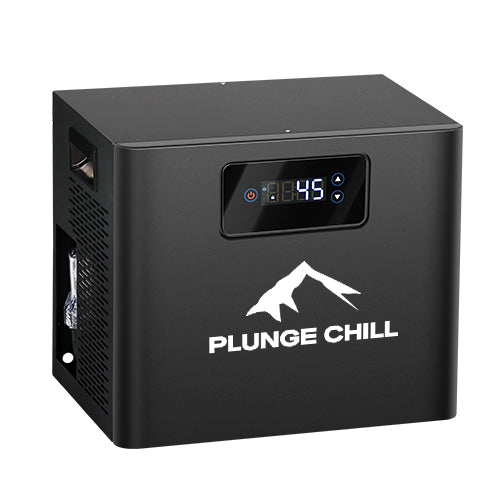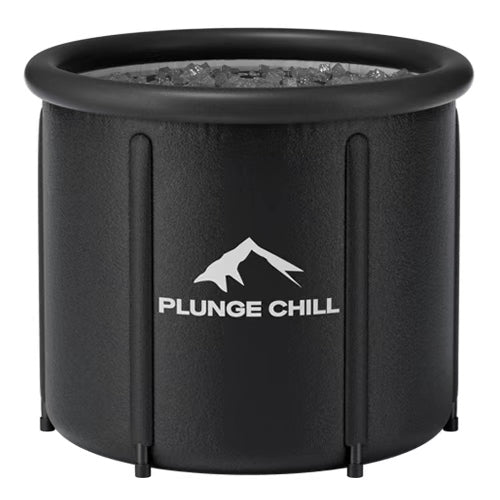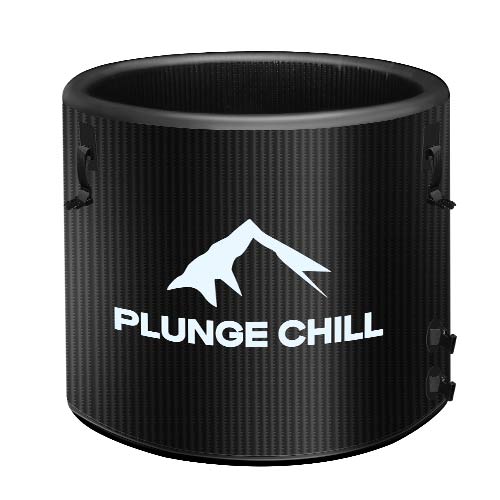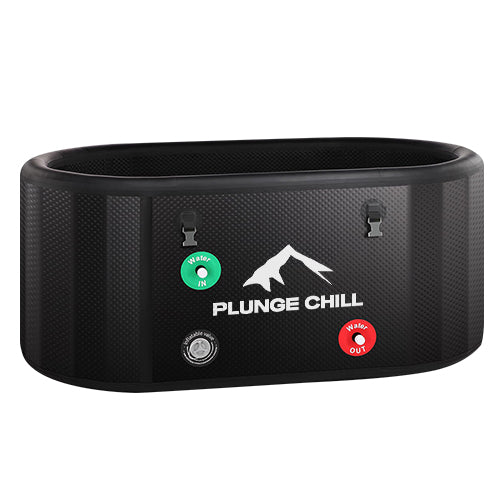Finding the best cold plunge chiller for your ice bath is essential. It should cool efficiently, fit your setup, and be budget-friendly. Size and energy efficiency are key—a chiller with a high energy rating uses less power, helping your wallet and the environment.
Compatibility is also crucial. If the chiller doesn’t match your setup, it can lead to uneven cooling or even system damage. You’ll enjoy a cold plunge system that performs well and lasts longer with the right choice.
Key Takeaways
- Match your chiller to the size of your ice bath and your needs.
- Set your chiller between 50°F and 60°F for optimal muscle recovery.
- Buy energy-saving chillers to lower power costs and help the planet.
- Regular cleaning and refrigerant checks help your chiller last longer.
- Choose a chiller with quiet operation and easy controls for a smoother experience.
Assessing Your Ice Bath Needs
How often will you use it?
Think about how often you’ll be using your ice bath—this plays a big role in choosing the right setup. If you’re only plunging once or twice a week, a simple and affordable system might be all you need. For athletes or anyone training hard, using it three to four times weekly is more common, and you’ll likely benefit from a more powerful, reliable chiller. Daily use is possible too, but research shows it may not offer much more recovery benefit than doing it a few times a week. In short, the frequency of your plunges helps determine how advanced your setup needs to be.
| Frequency Recommendation | Benefits | Risks |
| 1-2 times a week | Helps recovery, ease soreness | Low risk, safe for most people |
| 3-4 times a week | Better recovery for athletes | Might get too used to cold |
| Daily | Fast recovery | Less benefit over time |
Your goals matter—whether you're a beginner, a regular gym-goer, or a competitive athlete. Ice baths offer more than just physical recovery. Studies show that cold exposure may help reduce inflammation, speed up muscle repair, and support nervous system regulation. Regular use can also improve mood and mental focus by stimulating dopamine release and reducing cortisol levels. Many people—from first-timers to pros—say they feel calmer, more focused, and recharged after a plunge. It's a simple yet science-backed way to reset both body and mind and stay consistent with your fitness and recovery.
The best temperature for cold therapy
Staying within the 50°F to 60°F range is key to a safe and effective cold plunge. A good chiller helps maintain that temperature consistently, even with frequent use or in warmer weather. Strong cooling power means faster temperature drops and steady performance, giving you better control over your recovery routine.
Ice bath size and water amount
The size of your ice bath tubs when choosing a cold plunge chiller. Larger tubs need more powerful cold plunge chillers to keep the water cold. If your setup is portable, make sure the cold plunge chiller tubs your bath size and water volume. Also, remember that weather changes can impact cooling performance, so pick a cold plunge chiller designed to work well year-round.
Picking the Right Size and Power
Figuring out the cooling power you need
Getting the right cooling power is essential to maintain your ice bath at the desired temperature. Cooling power is typically measured in BTUs (British Thermal Units), which quantifies the amount of heat the chiller can remove per hour. To determine the cooling capacity you need, consider the size of your ice bath, the target water temperature, and how quickly you want the water to reach that temperature. A chiller with insufficient BTUs may struggle to cool effectively, while one with excessive capacity could waste energy. Balancing these factors ensures efficient and consistent performance.
Here’s a simple table to guide you:
| Factor | Example Value |
| Cooling Rate Formula | 500 BTU |
| Temperature Difference | 2°F |
| Ice Surface Area (min/max) | 68 SF / 90 SF |
Most home setups don’t need super-strong chillers. But if your tub is big or your area is hot, you’ll need more power.
Matching Your Chiller Size to Your Ice Bath
Choosing the right chiller size is crucial for an effective cold plunge experience. Your chiller should be matched to the size and water volume of your ice bath to maintain consistent temperatures.
- Small chillers are ideal for single-person baths.
- Most personal ice baths hold between 50 to 100 gallons of water.
- Larger baths or those used frequently require more powerful chillers.
For example, a 4-ton chiller can efficiently cool 3 to 5 baths, each holding around 200 liters of water.
For personal use, selecting a chiller designed for up to 80 gallons ensures reliable cooling.
A well-sized chiller keeps your bath cold even during heavy use, delivering a steady and consistent cold therapy experience every time.

Handling Temperature Changes Through the Year
Seasonal shifts can have a major impact on how well your cold plunge chiller performs. During the summer, ambient temperatures rise significantly, and your chiller has to work harder to maintain the target water range of 50°F to 60°F (7°C to 15.5°C). If the unit isn't powerful enough, it may struggle to cool efficiently during heatwaves or with high-frequency use.
Understanding your local climate is key when choosing a chiller. Reliable sources like NOAA (National Oceanic and Atmospheric Administration) and NASA provide trustworthy long-term weather and temperature trend data. NOAA regularly adjusts past climate records to correct errors, while NASA accounts for urban heat island effects to reflect real environmental conditions.
If you live in a region with hot summers or significant seasonal changes, it's worth investing in a chiller that can handle year-round use. This ensures your cold plunge stays effective and consistent regardless of the season. With a well-matched system, you won’t need constant manual adjustments, and you'll enjoy the same refreshing experience whether it's hot or cold outside.
Energy Efficiency and Long-Term Savings
Why energy-efficient chillers matter
Energy-efficient chillers save money and help the planet. They use less power, lowering your electricity bills. These chillers keep your ice bath cold without wasting energy. Newer models are better than older ones. For example, non-CFC chillers are 30-40% more efficient than older units. Over time, this means big savings, even if energy prices are low now.
Switching to an energy-saving chiller cuts costs and improves efficiency. It’s a smart choice for long-term use.
Features that boost energy efficiency
Not all chillers work the same way. Some have special features to save energy. Additives can improve heat transfer in the evaporator. Better refrigerant and lubricant mixes also increase cooling power. These upgrades create a thin layer on the evaporator, making it work better. Studies show these features can save up to 1% of yearly electricity. This may seem small, but it adds up for frequent users.
Ensuring Compatibility with Your Ice Bath Setup
Plumbing and electrical needs
Before buying a chiller, check your plumbing and power setup. Most chillers need steady water flow to work well. If your ice bath lacks a pump or filter, you may need one. This helps water move properly and stay cold.
For electricity, ensure your outlet supports the chiller’s power needs. Many chillers need their own circuit to prevent overloads. Check the voltage and amperage in the manual. If unsure, ask an electrician to avoid safety problems.
Portable or fixed chillers
Choosing portable or fixed chillers depends on your needs. Portable chillers are light and easy to move. They’re great if you change setups or travel with your bath. Fixed chillers are stronger and last longer. They’re better for permanent setups or bigger baths.
Think about how often you’ll use your bath and its location. If space is tight or you need flexibility, go portable. For long-term use, fixed chillers offer more power and stability.
Noise levels for comfort
No one wants a noisy chiller ruining their peace. Some chillers are loud, especially at full power. Look for models with quieter fans or insulated parts. Reading reviews can help you find a quieter option.
If using your bath indoors, noise matters even more. A loud chiller can disturb your peace or bother others. Always check the decibel rating to ensure a quiet, relaxing experience.
Budgeting for Your Water Chiller
Understanding price ranges and what to expect
Buying a water chiller for ice baths can cost different amounts. The price depends on size, cooling power, and extra features. Here's a simple breakdown:
| Aspect | Details |
| Market Trends | Prices change with local and global trends. |
| Market Segmentation | Costs differ by type, size, and use. |
| Key Drivers | Energy-saving models may cost more. |
| Competitive Analysis | Big brands charge extra for special features. |
For personal use, small chillers cost $500 to $2,000. Bigger, commercial ones can go over $5,000. Spending more upfront often means better quality and savings later.
Features that justify higher costs
Not all chillers are the same. Some have features that make them worth more. Look for these:
- Energy Efficiency: Uses less power, saving money over time.
- Durability: Strong materials like stainless steel last longer.
- Advanced Controls: Digital controls and filters make it easier to use.
- Noise Reduction: Quieter models have insulated parts or special fans.
These features help your chiller work better and last longer. They’re great for people who use ice baths often.
Tips for Finding a Reliable Cold Plunge Chiller on a Budget
You don’t need to spend a fortune to get an effective cold plunge chiller. At Plunge Chill, we’ve designed our chillers to be powerful enough for everyday use, while still keeping things simple and affordable.
- Pick the right size for your tub—no need to overdo it.
- Our built-in filters help keep your water clean with less maintenance.
- They're quiet, easy to use, and made for both indoor and outdoor setups.
- Plus, they’re backed by a solid warranty so you can plunge with confidence.
If you're just getting started or looking for a no-fuss option, Plunge Chill has you covered. Our best-selling model offers the perfect combination of simplicity and essential performance.
Durability, Maintenance, and Extra Features
Strong materials for long-lasting use
Pick a chiller made with strong materials for durability. Stainless steel or rust-proof alloys are great choices. They handle water and temperature changes well. Plastic parts may cost less but wear out quickly. Choose chillers with sturdy tubing and tough exteriors. This helps avoid frequent repairs or replacements. A strong chiller works better and lasts longer.
1HP COLD PLUNGE CHILLER
Easy maintenance to make your chiller last
- Clean tubes and coils yearly to save energy and cool better.
- Check refrigerant levels often for the best performance.
- Replace worn parts like filters or seals to stop leaks.
- Get professional servicing every few years to catch issues early.
Skipping maintenance can cause costly damage. A well-kept water-cooled chiller can last 25 years. Air-cooled ones usually last 15-18 years. Doing these tasks saves money and keeps your chiller in great shape.
Cool features like filters and temperature settings
New chillers have smart features that make them better. You can set the exact water temperature for your ice bath. This gives you a steady cold therapy experience. Some chillers also have filters to keep water clean. This means less cleaning for you.
Other upgrades, like cooling units and chimneys, improve airflow. They stop hot and cold air from mixing, saving energy. These features make your chiller more efficient and easier to use. Investing in these extras can improve your setup.
Picking the best water chiller for your ice bath depends on a few things. Think about size, how much it can hold, energy use, fit, price, and upkeep. For instance, water-cooled chillers use 46–57% less power than air-cooled ones. This makes them a great option for saving money over time. Choosing the right size is also important. Studies show that a well-matched chiller lowers energy use and works better.
Take some time to figure out what you need. How often will you use your ice bath? What temperature do you like? How much can you spend? Look for features that make it better, like being quiet or having easy temperature controls.










